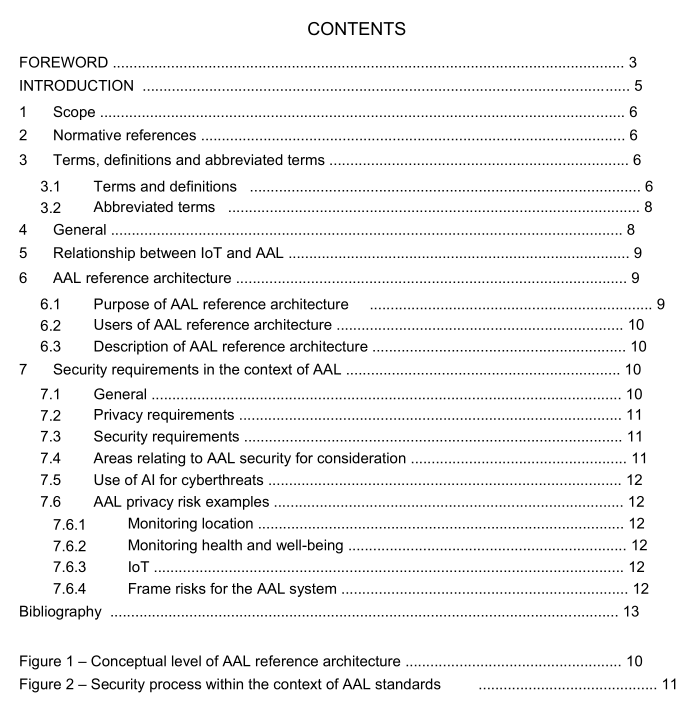IEC 63240-1 pdf – Active assisted living (AAL) reference architecture and architecture model – Part 1: Reference architecture

IEC 63240-1 pdf – Active assisted living (AAL) reference architecture and architecture model – Part 1: Reference architecture
5 Relationship between IoT and AAL AAL and IoT share a common technical architecture model and a technical “thing”-services- based framework with the emphasis on the AAL user who consumes or applies assisted living “thing”-related services. AAL is a specific use of IoT, if IoT is understood as the possibility of connectedness of things to each other. IoT is an enabler for other application systems and application domains. More specifically, it is an enabler for other “thing”-related services in these application systems and application domains. AAL can be considered as one instance of a “human-centric IoT” approach. This means that the base for AAL is the IoT technical architecture, but specific or different requirements exist due to the user-centricity of AAL. In AAL, users include lay operators who are not IT professionals as users. There are also other IoT application domains that are human-centric such as the patient-centric medical thing-related services or healthcare thing-related services.
AAL is a human-centric use of IoT to create adapted localities (e.g. homes, points-of-care) with the aim of assisting humans. AAL is a human-centric domain at the point-of-care where services to people based on technical, IoT services are most commonly applied. AAL utilizes IoT and designs thing-related services that serve the needs of an AAL user when interacting with the AAL cyber-physical system.
The AAL key requirements are safety, security, privacy, technical assistance and additional requirements (e.g. resilience and reliability of the system). These requirements can also apply to other domains where people play an important role such as the healthcare and medical domain. Smart home and smart energy are domains in which domain-specific smart thing-based services are applied. “Smart services” of these and other domains should be interoperable and combined in processes which serve the need of the user of such “smart”, connected services. AAL users can benefit from “smart”, connected services in which AAL services are combined with services of other domains. AAL systems are designed and implemented to assist people who are in need of AAL services realized by means of “things”.
6 AAL reference architecture
6.1 Purpose of AAL reference architecture The reference architecture defines concepts and introduces terminology on an abstract level. The reference architecture provides generic rules for designers of AAL systems and services with the aim to facilitate systems design and enable interoperability between components. The AAL reference architecture enables secure and interoperable AAL services (all AAL services, including end-to-end services) by describing the generic architecture. The purpose of the reference architecture is to develop a framework that provides an overall view on components and how they relate to each other, which enables users to fit use cases for AAL. Components could be actors, devices, and other building blocks. Thus, it describes connections between technical entities and associations of people to the technical entities. The reference architecture is specific to AAL; however, it is not limited to current technological solutions and use scenarios.
6.2 Users of AAL reference architecture Potential users of the AAL reference architecture are designers and developers of AAL systems and services, as well as manufacturers, procurers and all other stakeholders that are interested in an abstract framework that allows them to map their use cases. Users should use the reference architecture during the development of use cases, AAL services, systems, or components and to better understand how different components can be interconnected. User can develop guidelines for secure interoperability based on the reference architecture.
6.3 Description of AAL reference architecture
Figure 1 depicts the AAL reference architecture on a conceptual level. There can be a user interface in every building block. It shows the flow of information from one building block to the next over defined interfaces of the reference architecture. The AAL reference architecture consists of several building blocks. Building blocks are entities which are on their own or in combination with other entities capable of delivering AAL services. Building blocks are connected to each other by interfaces.









